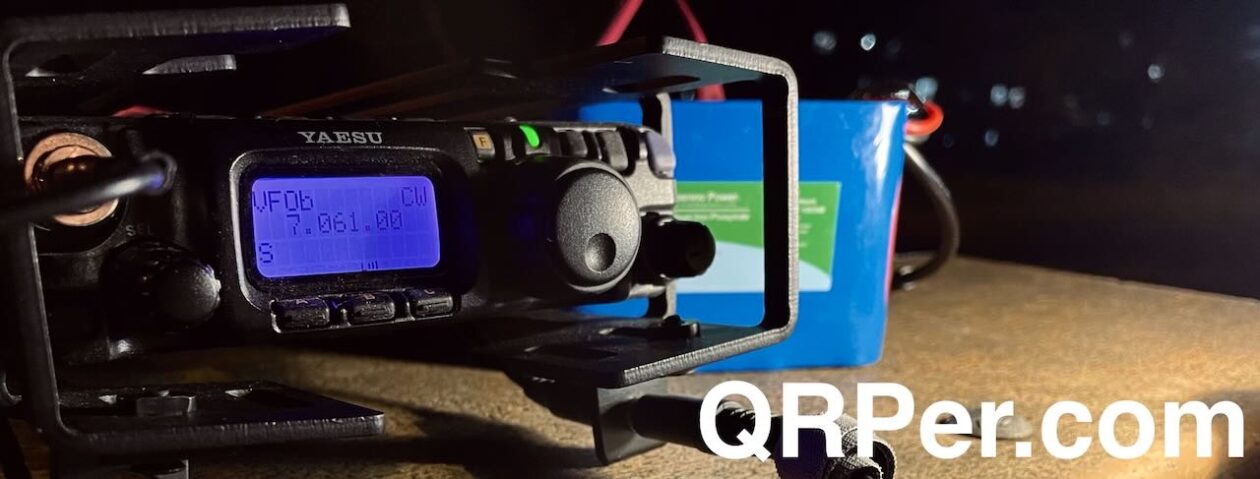On Tuesday, June 18, 2024, I needed to make a morning trip to Hickory, NC, to take care of some family business and visit my father.
I started my day early because I also wanted to be back in the Asheville area by noon. Some quick calculations over morning coffee and I decided I had just enough time to fit in one POTA activation en route to Hickory.
I left the QTH around 7:15 AM and made my way to the Paddy’s Creek Access of Lake James State Park, arriving around 8:15 AM.
Lake James State Park (US-2739)
 Two other reasons I fit in my activation en route to Hickory instead of on my way back:
Two other reasons I fit in my activation en route to Hickory instead of on my way back:
- Paddy’s Creek has a lakeside beach area that gets very busy in the summer, especially on clear, sunny days (like Tuesday).
- Temperatures that day were forecast to push near 95F/35C.
 When I arrived at the parking area, I was pleased to see I was one of the only cars there. This made it much easier to find a spot to set up!
When I arrived at the parking area, I was pleased to see I was one of the only cars there. This made it much easier to find a spot to set up!
 I started my activation video (see below) then walked to a picnic table under some trees that would not only provide shade but also antenna support!
I started my activation video (see below) then walked to a picnic table under some trees that would not only provide shade but also antenna support!
I deployed my KM4CFT end-fed half-wave kit that I cut as a 30M EFHW with a linked 40M extension. When I launched the arborist line into the dense canopy, I thought I snagged a high branch, but it turned out I hadn’t.

In the end, my 40M EFHW had more of a low inverted vee, almost NVIS-height, configuration. I was fine with that, though, knowing on the 40M band that early in the morning, I’d snag contacts in NC and the surrounding states.

My goal was to finally make some SSB contacts with the Xiegu X6200. My previous mid-day activation with the X6200 provided no results, so I was hoping I’d be more successful in the morning.
One other thing I did that I haven’t done in over four years: I started out my activation with more than 5 watts of power. I added an external battery to the X6200, turned off its internal charger, and ran the transceiver at its full output power of eight watts.
My goal was to see how warm/hot the chassis would become during the activation. This is one of the questions I’ve been asked the most about the X6200 so far.
Setting up the radio was simple. I was careful to make sure that the internal ATU was bypassed on the 40M (and later 20M) band.
Gear:
 Note: All Amazon, CW Morse, ABR, Chelegance, eBay, and Radioddity links are affiliate links that support QRPer.com at no cost to you.
Note: All Amazon, CW Morse, ABR, Chelegance, eBay, and Radioddity links are affiliate links that support QRPer.com at no cost to you.
- Xiegu X6200 via Radioddity (Save 5% off purchase amount when you shop with our affiliate link) and via Amazon.com
- KM4CFT EFHW Kit
- ABR Industries 25’ RG-316 cable assembly with three in-line ferrites (Use Coupon Code ABR10QRPER for 10% Discount!)
- Key cable: Cable Matters 2-Pack Gold-Plated Retractable Aux Cable – 2.5 Feet
- CW Morse Outdoor Paddle with Steel Base
- GoRuck GR1 USA
- Weaver arborist throw line/weight and storage bag
- GraphGear 0.9mm 1000 Automatic Drafting Pencil
- Rite In The Rain Top Spiral Notebook
- Camera: DJI OSMO 4 action camera with Joby Telepod Sport Tripod
- DJI Wireless Microphones
On The Air
 One of the other reasons I chose the Paddy’s Creek access of Lake James is that I knew for sure that I had mobile phone reception there, which I would need to self-spot in SSB mode. Continue reading Xiegu X6200 SSB Field Test: A Morning POTA Activation at Lake James
One of the other reasons I chose the Paddy’s Creek access of Lake James is that I knew for sure that I had mobile phone reception there, which I would need to self-spot in SSB mode. Continue reading Xiegu X6200 SSB Field Test: A Morning POTA Activation at Lake James
























































































